Introduction
My Mom and Dad’s head stone, front and back. They are buried in the same grave at Jefferson Barracks National Cemetery in Saint Louis County, Missouri.

Schuh, Harold T. Thurs., May 24, 2012. Beloved husband of Billie Schuh (nee Vaznaian); dear father of Sue (the late Mike) Williams, Sandy (Wally) Schlaegel and Donald (Leigh) Schuh; dear grandfather of Mark Williams, Cindy (Harry) Kleiner, Wally (Tracy) and Todd (Kala) Schlaegel, Elliott (Jennifer) Gion and Melissa (Adam) Colvin; dear great-grandfather of Brooke, Connor, Madison, Harrison, Jay, Erica, Ben, Keaton, Samantha and Dylan; our dear brother, uncle and wonderful friend.


Harold, Billie Schuh celebrate 70th wedding anniversary
November 30, 2011
Harold and Billie Schuh celebrated their 70th wedding anniversary Nov. 8 with dinner at their home in Green Park, where they have lived since June 19, 1955.Mr. Harold Schuh and the former Billie Vaznaian…
Harold and Billie Schuh of Green Park celebrated their 70th wedding anniversary on Nov. 8 with a dinner in their home. The couple were married on Nov. 8, 1941. They have lived in the same home since June 19, 1955.
Harold is retired from Krey Packing Co. where he worked for 32 years. Billie is retired from the Lindbergh School District.
The couple has three children: Sandy (Wally) Schlaegel of Arlington, Texas; Don (Leigh) Schuh of Cottleville, Mo.; Sue Williams of Eugene, Oregon . They also have six grandchildren and 10 great-grandchildren.

Notice of Classification. With a 1-A you are able to be drafted.

Pearl Harbor
The route and time it took for the Japanese to arrive at Pearl Harbor.

Pearl Harbor

Location of the American ships docked at Pearl Harbor. The circle shows the location of Helena during the attack.

During the attack on Pearl Harbor the Helena was struck by a torpedo approximately mid ship.
Flames shot through the ship killing approximately 20 sailors. 31 sailors gave their life that day.

The day after the attack on December 8th. The Helena was being taken to dry dock for repairs, to make her sailable back to the states.

Boot Camp
When signing up for the navy Dad was given this voucher for breakfast at the train station before leaving for Boot Camp.

At Boot Camp the sailors were taught how to tie their hammocks.
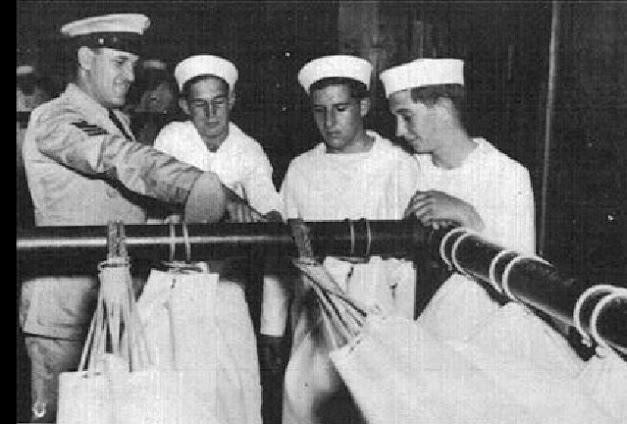
Boot Camp was the last time my father ever slept in a hammock

Meeting the USS Helena CL50
The Helena CL50

My Mom and Dad on the roof of St. George Hotel, Vallejo California.

Mary and Joe Scepinski. They shared an apartment while working on the Helena.

The top left photo is a contact mine with small horns would float on the surface or would be held just under the surface of the water. When a ship hits a mine, it breaks a glass vial in the horn, causing a liquid to flow. The bottom photo is a magnetic mine. A magnetic mine does not need contact to explode. A magnetic mine lays on the floor of the ocean and detonates when triggered by a ships magnetic signature.
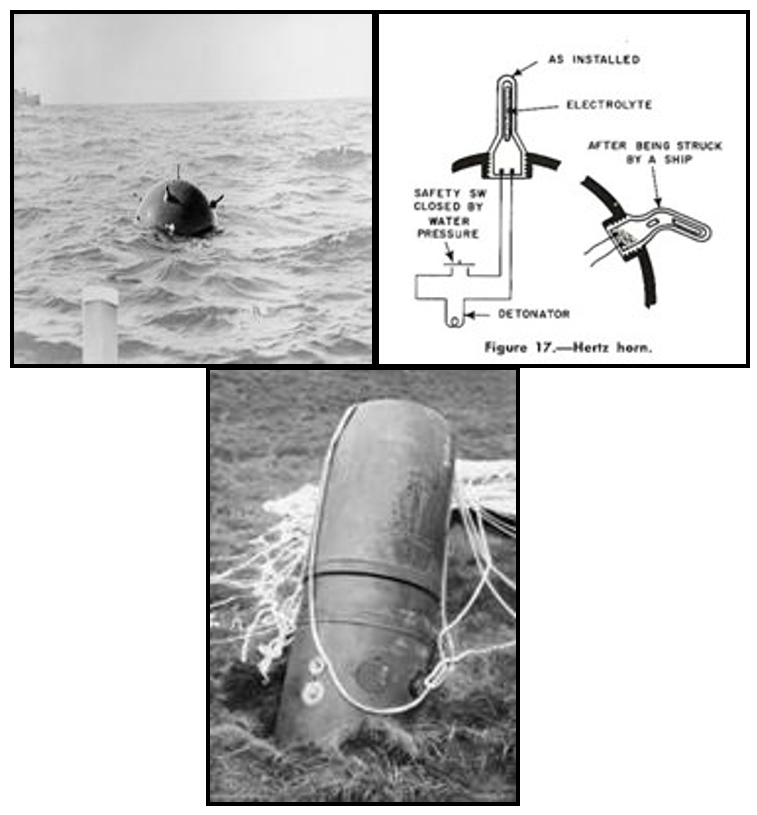
Harold Schuh before shipping out on the Helena.

Traveling to the Solomon’s
Given out when crossing the International Dateline, you went from a plywog to a Shellback

Traveling to the Solomon’s
The Solomon Islands

Savo Island; the Japanese launched a naval attack on the US Navy off Savo Island) on August 8,1942. This was known as ‘The First Battle of Savo Island (The Helena was not part of this battle) This was a drastic loss for the United States, and it started the six-month fight over Guadalcanal Island.

On August 11, the Helena arrived in Segond Channel), Espiritu Island, New Hebrides (Vanuatu). During the Pacific War, New Hebrides was a major staging area early in the war for the Guadalcanal campaign. On March 18, 1942, the Marines started developing a base for our American forces. At that time, the New Hebrides base was the most forward American base in the Solomon’s.

Location of segond Channel; Helena came here many times to rest, refuel and pick up supplies.

Location of Port Vila; Another port in New Hebrides (Vanuatu). Helena came here to rest, refuel, pick up supplies and soldiers.

The Helena and other war ships patrolled the slot, Indispensable Strait, Sea lark Channel and Iron Bottom Sound.

The Sinking of the USS WASP
The USS Wasp was conducting flight and transport operations over the lower Solomon’s Islands. She was escorting transports containing men of the 7th Marine Regiment destined for Guadalcanal.

The WASP was found by a Japanese submarine, which let go with a spread of torpedoes. The WASP was struck twice on starboard. When the torpedoes exploded the WASP listed to starboard. Five minutes later there was another large explosion. There was explosion after explosion until the WASP was totally engulfed in flames. Her sailors fought the fires for hours until the captain had to order abandon ship.
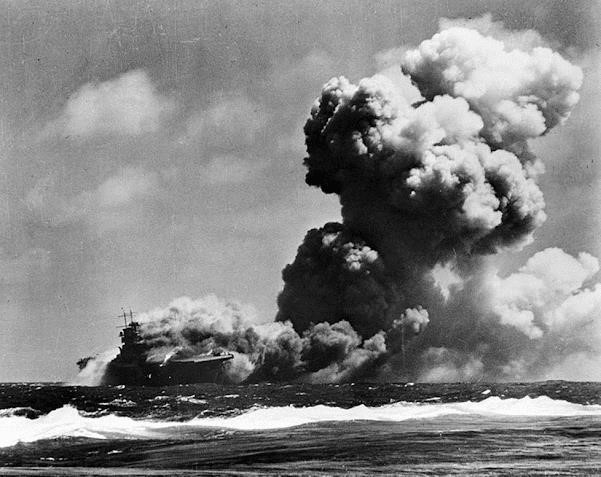
The Battle of Cape Esperance
Location of Cape Esperance, on Guadalcanal Island. Japanese Warships and transports filled with troops and supplies would come down the slot at night. The transports would deliver their cargo to Cape Esperance and bomb Henderson field. The Sea Battle of Cape Esperance took place between the Cape and Savo Island.

Crossing the T; Our ships were LUCKY they were in the perfect location. All our guns could be used against the enemy but only their bow guns could shoot at us. This was called crossing the T and gave us a significant tactical advantage.
The Helena reported that their radar had detected enemy ships on starboard. The captain of the Farenholt also received the message and realized his van destroyers were in trouble. Knowing they were now in the line of fire he ordered the Laffey to speed up and quickly get to the front of the column out of any crossfire.

Between Two Great Battles
Task Force 64 was traveling in a column, San Francisco, Helena and Chester and the Anti-Submarine screen; Walke, Buchanan, McCalla and Laffey. The Chester was hit by a torpedo, 30 seconds later there was an explosion 200 yards off the port bow of the Chester. In the next 30 seconds an explosion about 500 yards off the port quarter of the Helena, and an explosion 250 yards off the port quarter of the San Francisco. Another one was spotted on the port quarter of the Helena. 30 seconds later, another one was spotted on its starboard side about 200 yards away. The torpedoes were set to explode at the end of their run. Five detonations were noted, and the sixth one did not detonate.

The Battle of Guadalcanal
The Helena and twelve other ships headed into the waters of Iron Bottom Sound. Task Force 67 had to stop these enemy ships, even if every ship had to be sacrificed. Our Task Force 67 of 13 was alone with no other support. There were three enemy groups identified. The far-left group contained at least two heavy cruisers and three destroyers. The upper-left group contained one battleship, a light cruiser, and several destroyers. The group ahead was now on our columns starboard (right), and it contained two light cruisers and four destroyers. The least number of ships in the three groups totaled 16. Now the ships picked up a fourth and fifth enemy group. At least 30 enemy ships were now surrounding our war ships. The battle was about to start, and it would only last 34 minutes


The Kingfisher aircraft were part of all cruisers. Each cruiser would catapult the planes to search for Japanese. When they return to the cruiser land the Kingfisher would land in the sea and would be picked up by a crane and placed back on the ship.
The Sinking the USS Juneau
After the sea battle of Guadalcanal, the USS Juneau had been crippled by a torpedo. She could barely sail. A Japanese submarine caught up with her and again and torpedoed her in the same location where the other one hit. The explosion totally blew the ship apart. The five Sullivan brothers were all killed when the ship sunk.
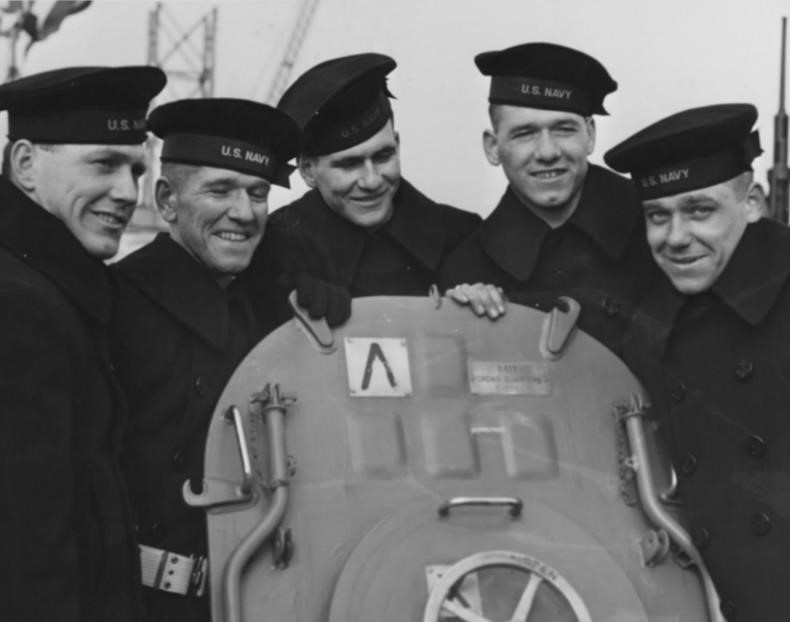
If Only This War Would End
Kula Gulf was Very important, our ships would travel to the bottom of the gulf and shell Munda and Vila Airfields.

The Island and Australia
The Helena was given orders, that stated she was operating as a detached unit under the direct control of Commander South Pacific. Dad was at sea for 226 days before setting foot on land. March 2, 1943, the Helena anchored in a bay off Noumea Island, New Caledonia, on an island that was two miles wide and six miles long. It was beautiful with white sand and coconut groves.

The Helena left the Island, but had no idea where they were going but was surprised when she ended up in Australia. They arrived at Jackson Harbor, Sidney, Australia on March 6th, 1943 and moored the ship till the 10th. The ship was placed on keel-blocks in Shuterland dry dock on the 11th and on March 18th the Helena left the dry dock and moved to pier 9, Wooloomooloo Bay. We degauss the ship and was on our way. The stay in Australia lasted 20 days.
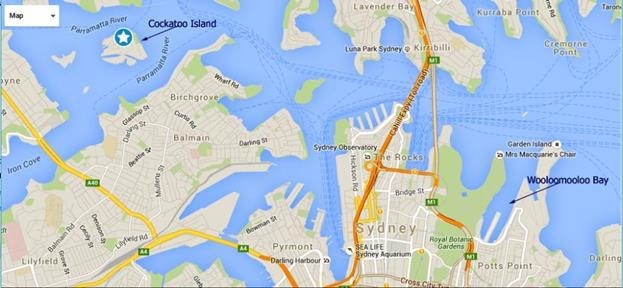
The Mighty H did not Survive
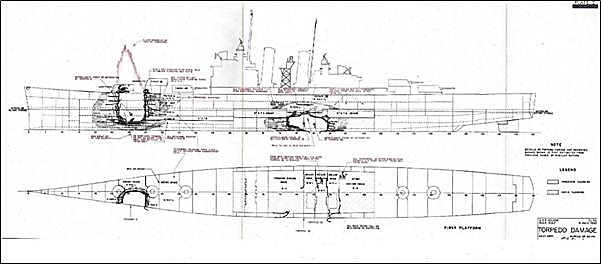
July 6, 1943 the Helena while in a fire fight was torpedoed in the bow, which sheared off 110 feet of the ship. Two minutes later a second torpedo hit mid ship and then a third one hit where the second one hit. The bow including all of turret one was blown off. The remaining part of the ship was breaking apart at about the number two stack. The Helena broke into three sections and sunk in 27 minutes from the time of the hit.
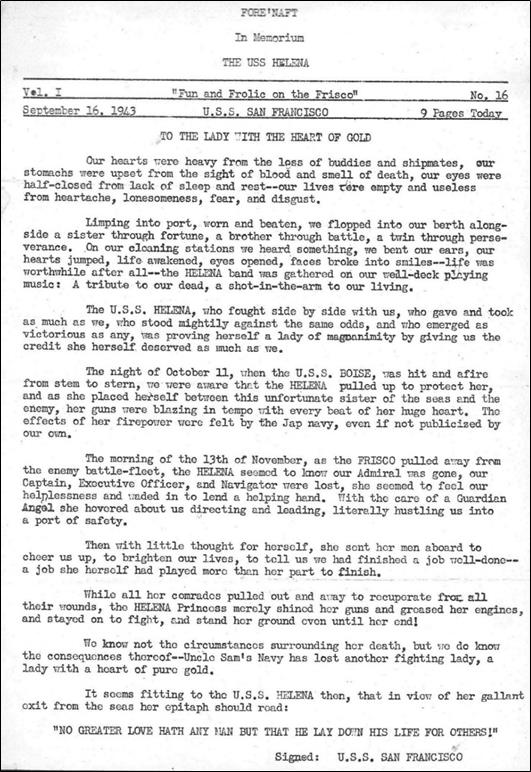
Letter from Dad to Mom, written on June 24 and did not arrive until after July 10. July 6 The Helena was sunk and within six days of the Helena sinking, it appeared in the local newspapers at home. Before anyone was notified or had a chance to send a message to their loved ones. Normally there is a waiting period until all immediate relatives are notified, but not this time. July 12, Mom found out the Helena sunk. July 19, she finally received my telegraph.


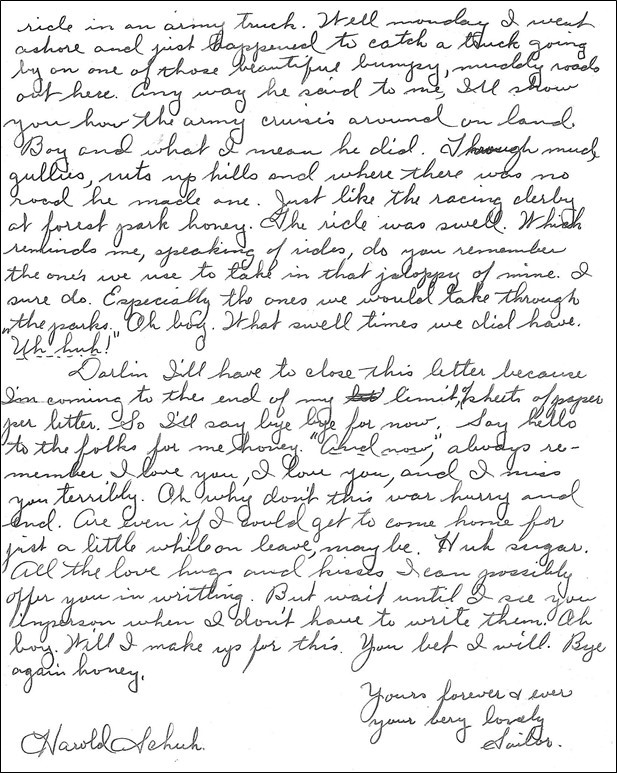
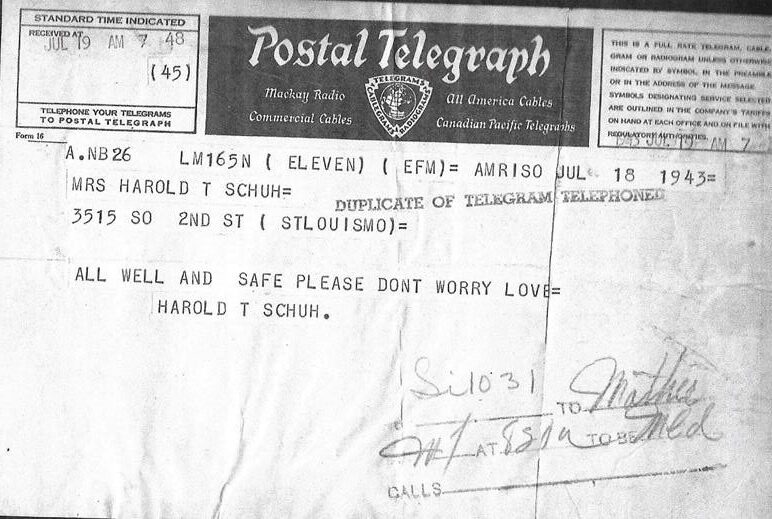



News Paper articles about the Helena from the Globe Democrat and the Post Dispatch.




Coming Home and Going Back
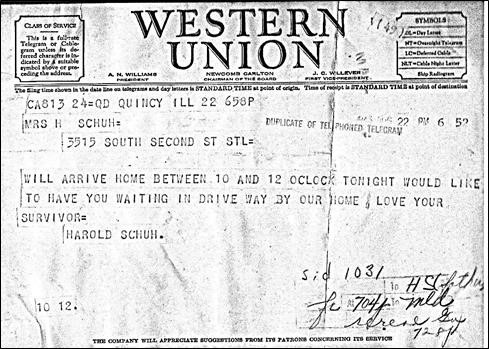
Asked for another week extension to the 30-day leave. Telegraph states leave was granted.


Meeting the USS Houston CL81
The USS Houston CL81


When my dad and Francis Meier got off the train in Newport News, Virginia they went for a drink. Neither one wanted to go back to war. They wrote on this napkin in hopes they would be coming back from the war a second time
Mom left her job to join Dad while working on the USS Houston. Mom was doing her part for the war working on the gyroscopes within the torpedoes for submarines.

Amertorp Corporation in-house paper.


They moved the USS Houston to Norfolk, Virginia. Mom and Dad moved into this trailer. Here is another couple they made friends with.




Dad received the two messages a month after Helena Sue was born.


Fast Carrier Forces Pacific Operation
The Houston was torpedoed a second time. She was crippled but stayed afloat and a year later returned to New York, never to go back to war.

The Houston was being towed in hope the Japanese would find her drawing them to a trap. Each person on the ship at that time was given this certificate. A little humor is OK during war.

The USS Hector was a repair ship and was waiting for the Houston. This was her biggest repair job of the war. Its job was to make Houston seaworthy so that it could sail back to New York. November 23rd was Thanksgiving and the USS Hector treated the Helena to a wonderful Thanksgiving Day dinner and a show .


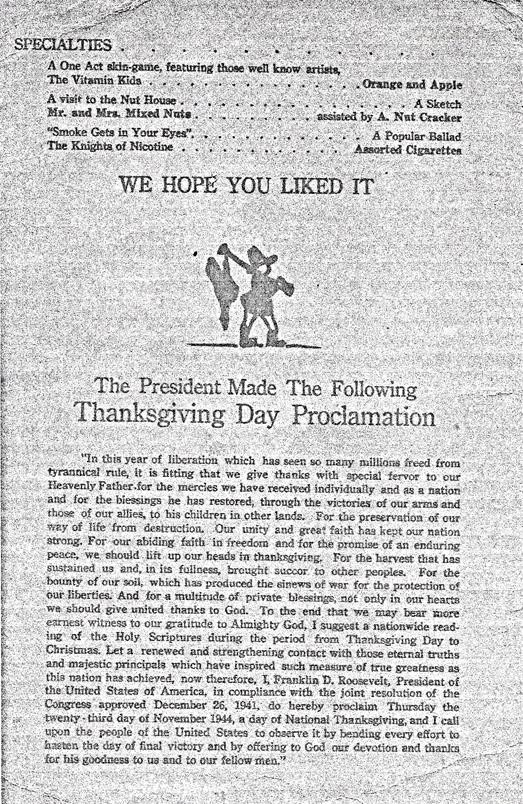
Location where both torpedoes hit Houston.

October 27, the Houston arrived at Ulithi Atoll and entered Mugai Channel. The USS Hector was a repair ship and was waiting for the Houston. During the repair work 30 more sailor bodies were recovered from the flooded compartments. The ship performed funeral services for the men and their remains were taken to Asor Island for burial one of the Ulithi Islands. Finally, on December 14th the Hector cleared the port side and the Houston was being towed back to New York.
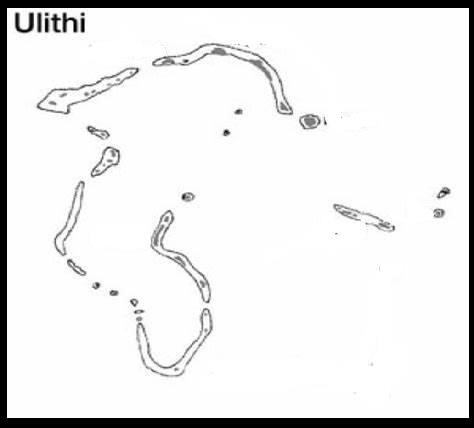
The Journey Comes to an End
Notice of Classification of discharge, I-D Disc.

Harold Schuh’s Honorable Discharge.


At the end of the war, Dad had this photo taken. Harold, Billie and Helena Sue Schuh.
